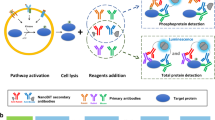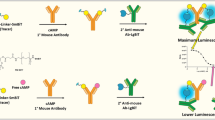Abstract
Cortisol is an important glucocorticoid in humans that regulates many physiological processes. Human 11β-hydroxysteroid dehydrogenase type 1 (11β-HSD1) converts cortisone to cortisol in vivo and has emerged as an appealing therapeutic target for treating metabolic diseases. Here, we report a sensitive and robust high-throughput (HT) cell-based assay for screening 11β-HSD1 inhibitors. This assay utilizes a HEK293 cell line transduced by a BacMam virus expressing human 11β-HSD1. The enzyme activity in the cells was measured by quantifying cortisol levels released into the cell culture supernatant via a competitive homogenous time-resolved fluorescence (HTRF) method. We show that 11β-HSD1 activity in supernatant of BacMam-transduced HEK293 cells increases with 11β-HSD1 BacMam virus load in a dose-dependent manner, and is comparable to the enzyme activity detected in differentiated mouse adipocytes. In addition, we show that co-expression of hexose-6-phosphate dehydrogenase (H6PDH) is not required for the enzyme to function effectively as an oxo-reductase. This assay has been developed in low-volume 384-well format and it is sensitive, robust, and amenable to HT screening.








Similar content being viewed by others
References
Sapolsky, R. M., Romero, L. M., & Munck, A. U. (2000). How do glucocorticoids influence stress responses? Integrating permissive, suppressive, stimulatory, and preparative actions [Review]. Endocrine Reviews, 21, 55–89.
Lakshmi, V., & Monder, C. (1988). Purification and characterization of the corticosteroid 11 beta-dehydrogenase component of the rat liver 11 beta-hydroxysteroid dehydrogenase complex. Endocrinology, 123, 2390–2398.
Krozowski, Z., Li, K. X. Z., Koyama, K., Smith, R. E., Obeyesekere, V. R., Stein-Oakley, A., Sasano, H., Coulter, C., Cole, T., & Sheppard, K. E. (1999). The type I and type II 11 beta-hydroxysteroid dehydrogenase enzymes. The Journal of Steroid Biochemistry and Molecular Biology, 69, 391–401.
Bujalska, I. J., Draper, N., Michailidou, Z., Tomlinson, J. W., White, P. C., Chapman, K. E., Walker, E. A., & Stewart, P. M. (2005). Hexose-6-phosphate dehydrogenase confers oxo-reductase activity upon 11 beta-hydroxysteroid dehydrogenase type 1. Journal of Molecular Endocrinology, 34, 675–684.
Hewitt, K. N., Walker, E. A., & Stewart, P. M. (2005). Minireview: Hexose-6-phosphate dehydrogenase and redox control of 11{beta}-hydroxysteroid dehydrogenase type 1 activity. Endocrinology, 146, 2539–2543.
Barash, V., Erlich, T., & Bashan, N. (1990). Microsomal hexose-6-phosphate and 6-phosphogluconate dehydrogenases in extrahepatic tissues: human placenta and pig kidney cortex. Biochemistry International, 20, 267–274.
Kulkarni, A. P., & Hodgson, E. (1982). Mouse liver microsomal hexose-6-phosphate dehydrogenase. NADPH generation and utilization in monooxygenation reactions. Biochemical Pharmacology, 31, 1131–1137.
Tomlinson, J. W., Walker, E. A., Bujalska, I. J., Draper, N., Lavery, G. G., Cooper, M. S., Hewison, M., & Stewart, P. M. (2004). 11beta-Hydroxysteroid dehydrogenase type 1: A tissue-specific regulator of glucocorticoid response. Endocrine Reviews, 25, 831–866.
Lavery, G. G., Walker, E. A., Draper, N., Jeyasuria, P., Marcos, J., Shackleton, C. H., Parker, K. L., White, P. C., & Stewart, P. M. (2006). Hexose-6-phosphate dehydrogenase knock-out mice lack 11 beta-hydroxysteroid dehydrogenase type 1-mediated glucocorticoid generation. The Journal of Biological Chemistry, 281, 6546–6551.
Jamieson, P. M., Chapman, K. E., Edwards, C. R., & Seckl, J. R. (1995). 11 beta-Hydroxysteroid dehydrogenase is an exclusive 11 beta-reductase in primary cultures of rat hepatocytes: Effect of physicochemical and hormonal manipulations. Endocrinology, 136, 4754–4761.
Wang, M. (2006). Inhibitors of 11b-hydroxysteroid dehydrogenase type 1 for the treatment of metabolic syndrome. Current Opinion in Investigational Drugs, 7, 319–323.
Masuzaki, H., Paterson, J., Shinyama, H., Morton, N. M., Mullins, J. J., Seckl, J. R., & Flier, J. S. (2001). A transgenic model of visceral obesity and the metabolic syndrome. Science, 294, 2166–2170.
Fotsch, C., Askew, B. C., & Chen, J. J. (2005). 11 beta-Hydroxysteroid dehydrogenase-1 as a therapeutic target for metabolic diseases [Review]. Expert Opinion on Therapeutic Patents, 15, 289–303.
Schweizer, R. A. S., Atanasov, A. G., Frey, B. M., & Odermatt, A. (2003). A rapid screening assay for inhibitors of 11 beta-hydroxysteroid dehydrogenases (11 beta-HSD): Flavanone selectively inhibits 11 beta-HSD1 reductase activity. Molecular and Cellular Endocrinology, 212, 41–49.
Barton, P. J., Clarke, D. S., Davies, C. D., Hargreaves, R. B., Pease, J. E., & Rankine, M.T. (2004). PCT/GB2003/003171(WO 2004/011410 A1), 1–147.
Xu, R. D., Sang, B. C., Navre, M., & Kassel, D. B. (2006). Cell-based assay for screening 11 beta-hydroxysteroid dehydrogenase inhibitors using liquid chromatography/tandem mass spectrometry detection. Rapid Communications in Mass Spectrometry, 20, 1643–1647.
Enomoto, K., Araki, A., Nakajima, T., Ohta, H., Dohi, K., Preaudat, M., Seguin, P., Mathis, G., Suzuki, R., Kominami, G., et al. (2002). High-throughput miniaturized immunoassay for human interleukin-13 secreted from NK3.3 cells using homogenous time-resolved fluorescence. Journal of Pharmaceutical and Biomedical Analysis, 28, 73–79.
Mathis, G. (1993). Rare earth cryptates and homogeneous fluoroimmunoassays with human sera. Clinical Chemistry, 39, 1953–1959.
Claret, E. J., Ouled-Diaf, J., & Seguin, P. (2003). Homogeneous time resolved fluorescence assay to measure histamine release. Combinatorial Chemistry & High Throughput Screening, 6, 789–794.
Enomoto, K., Aono, Y., Mitsugi, T., Takahashi, K., Suzuki, R., Preaudat, M., Mathis, G., Kominami, G., & Takemoto, H. (2000). High throughput screening for human interferon-gamma production inhibitor using homogenous time-resolved fluorescence. Journal of Biomolecular Screening, 5, 263–268.
Clarke, E. E., & Shearman, M. S. (2000). Quantitation of amyloid-beta peptides in biological milieu using a novel homogeneous time-resolved fluorescence (HTRF) assay. Journal of Neuroscience Methods, 102, 61–68.
Mathis, G. (1999). HTRF(R) technology. Journal of Biomolecular Screening, 4, 309–314.
Kolb, A. (1997). A homogenous, time-resolved fluorescence method for drug discovery. In Devlin, J. P., & Kolb, A. (Eds.), High throughput screening: The discovery of bioactive substance (pp. 345–360). Marcel Dekker.
Grepin, C., & Pernelle, C. (2000). High-throughput screening evolution of homogeneous time resolved fluorescence (HTRF) technology for HTS. Drug Discovery Today, 5(5), 212–214.
Mathis, G. (1995). Probing molecular interactions with homogeneous techniques based on rare earth cryptates and fluorescence energy transfer. Clinical Chemistry, 41, 1391–1397.
Gu, X., Dragovic, J., Koo, G. C., Koprak, S. L., LeGrand, C., Mundt, S.S., Shah, K., Springer, M. S., Tan, E.Y., Thieringer, R., et al. (2005). Discovery of 4-heteroarylbicyclo[2.2.2]octyltriazoles as potent and selective inhibitors of 11 beta-HSD1: Novel therapeutic agents for the treatment of metabolic syndrome. Bioorganic & Medicinal Chemistry Letters, 15, 5266–5269.
Condreay, J. P., Witherspoon, S. M., Clay, W. C., & Kost, T. A. (1999). Transient and stable gene expression in mammalian cells transduced with a recombinant baculovirus vector. Proceedings of the National Academy of Science of the United States of America, 96, 127–132.
Fornwald, J. A., Wang, D., Lu, Q., Wang, D., & Ames, R. S. (2007). Gene expression in mammalian cells using BacMam, a modified baculovirus system. In D. W. Murhammer (Ed.), Methods in molecular biology, baculovirus and insect cell expression protocols (Vol. 338, pp. 95–114). Totowa, NJ: Humana Press.
Liu, Y., Sun, W. L., Sun, Y., Hu, G., & Ding, G. X. (2006). Role of 11-beta-hydroxysteroid dehydrogenase type 1 in differentiation of 3T3-L1 cells and in rats with diet-induced obesity. Acta Pharmacologica Sinica, 27, 588–596.
Lysko, P. G., Weinstock, J., Webb, C. L., Brawner, M. E., & Elshourbagy, N. A. (1999). Identification of a small-molecule, nonpeptide macrophage scavenger receptor antagonist. The Journal of Pharmacology and Experimental Therapeutics, 289, 1277–1285.
Ames, R., Fornwald, J., Nuthulaganti, P., Trill, J., Foley, J., Buckley, P., Kost, T., Wu, Z., & Romanos, M. (2004). BacMam recombinant baculoviruses in G protein-coupled receptor drug discovery. Receptors & Channels, 10, 99–107.
Condreay, J. P., Ames, R. S., Hassan, N. J., Kost, T. A., Merrihew, R. V., Mossakowska, D. E., Pountney, D. J., & Romanos, M. A. (2006). Baculoviruses and mammalian cell-based assays for drug screening. Advances in Virus Research, 68, 255–286.
Scott, M. J., Modha, S. S., Rhodes, A. D., Broadway, N. M., Hardwicke, P. I., Zhao, H. J., Kennedy-Wilson, K. M., Sweitzer, S. M., & Martin, S. L. (2007). Efficient expression of secreted proteases via recombinant BacMam virus. Protein Expression and Purification, 52, 104–116.
Kost, T. A., Condreay, J. P., Ames, R. S., Rees, S., & Romanos, M. A. (2007). Implementation of BacMam virus gene delivery technology in a drug discovery setting. Drug Discovery Today, 12, 396–403.
Ames, R. S., Kost, T. A., & Condreay, J. P. (2007). BacMam technology and its application to drug discovery. Expert Opinion on Drug Discovery, 2, 1669–1681.
Liu, Y., Sun, Y., Zhu, T., Xie, Y., Yu, J., Sun, W. L., Ding, G. X., & Hu, G. (2007). 11 beta-Hydroxysteroid dehydrogenase type 1 promotes differentiation of 3T3-L1 preadipocyte. Acta Pharmacologica Sinica, 28, 1198–1204.
Atanasov, A. G., Nashev, L. G., Schweizer, R. A. S., Frick, C., & Odermatt, A. (2004). Hexose-6-phosphate dehydrogenase determines the reaction direction of 11 beta-hydroxysteroid dehydrogenase type 1 as an oxoreductase. FEBS Letters, 571, 129–133.
Zhang, J. H., Chung, T. D., & Oldenburg, K. R. (1999). A simple statistical parameter for use in evaluation and validation of high throughput screening assays. Journal of Biomolecular Screening, 4, 67–73.
Su, X., Vicker, N., Lawrence, H., Smith, A., Purohit, A., Reed, M. J., & Potter, B. V. (2007). Inhibition of human and rat 11beta-hydroxysteroid dehydrogenase type 1 by 18beta-glycyrrhetinic acid derivatives. The Journal of Steroid Biochemistry and Molecular Biology, 104, 312–320.
Monder, C., Stewart, P. M., Lakshmi, V., Valentino, R., Burt, D., & Edwards, C. R. (1989). Licorice inhibits corticosteroid 11 beta-dehydrogenase of rat kidney and liver: In vivo and in vitro studies. Endocrinology, 125, 1046–1053.
Buhler, H., Perschel, F. H., & Hierholzer, K. (1991). Inhibition of rat renal 11 beta-hydroxysteroid dehydrogenase by steroidal compounds and triterpenoids; structure/function relationship. Biochimica et Biophysica Acta, 1075, 206–212.
Acknowledgements
We wish to thank Gordon McIntyre and Thomas Meek for their support in working on the program.
Author information
Authors and Affiliations
Corresponding author
Rights and permissions
About this article
Cite this article
Wang, DY., Lu, Q., Walsh, S.L. et al. Development of a High-Throughput Cell-Based Assay for 11β-Hydroxysteroid Dehydrogenase Type 1 Using BacMam Technology. Mol Biotechnol 39, 127–134 (2008). https://doi.org/10.1007/s12033-008-9050-y
Published:
Issue Date:
DOI: https://doi.org/10.1007/s12033-008-9050-y




